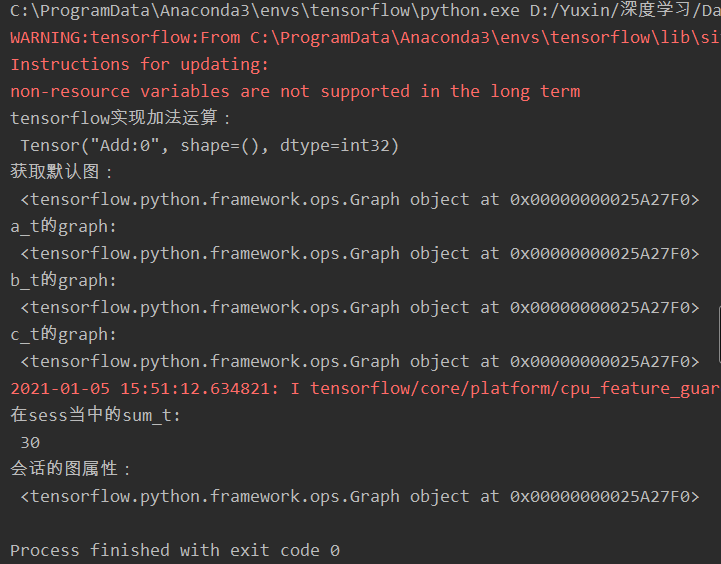1. 默认图
import tensorflow.compat.v1 as tf tf.disable_v2_behavior() def graph_demo(): # 图的演示 a_t = tf.constant(10) b_t = tf.constant(20) c_t = tf.add(a_t, b_t) print("tensorflow实现加法运算: ", c_t) # 获取默认图 default_g = tf.get_default_graph() print("获取默认图: ", default_g) # 数据的图属性 print("a_t的graph: ", a_t.graph) print("b_t的graph: ", b_t.graph) # 操作的图属性 print("c_t的graph: ", c_t.graph) # 开启会话 with tf.Session() as sess: sum_t = sess.run(c_t) print("在sess当中的sum_t: ", sum_t) # 会话的图属性 print("会话的图属性: ", sess.graph) return None graph_demo()
运行结果:

获取默认图:
tf.get_default_graph()
可知变量a_t,b_t,c_t以及会话session所在的图都在默认图当中。
如何去除运行结果中间这行红色的字:
Your CPU supports instructions that this TensorFlow binary was not compiled to use: AVX2
只需要在代码中加入如下两行:
import os
os.environ['TF_CPP_MIN_LOG_LEVEL'] = '2'
2. 创建图
-
可以通过tf.Graph()自定义创建图
-
如果要在这张图中创建OP,典型用法是使用tf.Graph.as_default()上下文管理器
# 自定义图 new_g = tf.Graph() print("自定义图: ", new_g) # 在自定义图中去定义数据和操作 with new_g.as_default(): new_a = tf.constant(30) new_b = tf.constant(40) new_c = tf.add(new_a, new_b) # 数据的图属性 print("new_a的graph: ", new_a.graph) print("new_b的graph: ", new_b.graph) # 操作的图属性 print("new_c的graph: ", new_c.graph) with tf.Session(graph=new_g) as sess2: sum_new = sess2.run(new_c) print("在sess2当中的sum_new: ", sum_new) print("会话的图属性: ", sess2.graph)

不同的图之间不能互相访问。
很少会同时开启不同的图,一般用默认的图就够了。
with tf.Session(graph=new_g) as sess2: sum_new = sess2.run(new_c) print("在sess2当中的sum_new: ", sum_new) print("会话的图属性: ", sess2.graph)
如果有多个图,需要多个会话来开启。